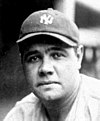Babe Ruth's called shot
Various reasons have been given with one being Yankee manager Joe McCarthy's grudge against the Cubs who had fired him in 1930, despite winning the National League pennant the previous season.
Using his mid-season arrival as the reason, the Cubs players voted that Koenig would only get half of his World Series bonus, which his old Yankee teammates saw as an insult when they'd heard.
Before Game 3, Chicago fans had joined in the fury, supposedly cursing and spitting on Ruth and his wife Claire as they arrived at Wrigley Field.
In 2020, an audio clip was discovered from a radio show that originally aired on October 6, 1932 in which Lou Gehrig said that Ruth was indeed pointing toward the flagpole in center field.
Calling the game over the radio, broadcaster Tom Manning shouted, "The ball is going, going, going, high into the center-field stands ... and it is a home run!"
[4] Newsreel footage, available in MLB's 100 Years of the World Series, showed that Ruth was crowding the plate and nearly stepped forward out of the batter's box, inches away from the risk of being called out (Rule 6.06a).
][citation needed] have claimed that Ruth "thumbed his nose" at the Cubs dugout, but the existing newsreel footage does not show that.
The Associated Press game report stated that Ruth raised four fingers, signifying a home run, as he ran the bases.
[5] Attending the game was Franklin D. Roosevelt,[6] then a presidential candidate, as well as 12-year-old boy and future Associate Justice of the United States Supreme Court John Paul Stevens.
[8] Root remained in the game but for only one more pitch, which the next batter, Lou Gehrig, hit into the right-field seats for his second home run of the day.
Ruth's second home run in Game 3 of the 1932 World Series might have been a mere footnote in history had it not been for reporter Joe Williams, a respected but opinionated sports editor for the Scripps-Howard newspapers.
In a late edition the same day of the game, Williams wrote this headline that appeared in the New York World-Telegram, evoking billiards terminology: "RUTH CALLS SHOT AS HE PUTS HOME RUN NO.
"[9] Williams' summary of the story read: "In the fifth, with the Cubs riding him unmercifully from the bench, Ruth pointed to center and punched a screaming liner to a spot where no ball had been hit before."
The story was likely to meet with acceptance among the public, who were aware of Ruth's many larger-than-life achievements and his well-publicized fulfilled promise to sick child Johnny Sylvester that he would hit a home run.
"[2] At the time, Ruth did not clarify the matter, initially stating that he was merely pointing toward the Cubs' dugout to remind them that he still had one more strike.
In an interview with Chicago sports reporter John Carmichael, Ruth said that he had not pointed to any particular spot, but that he just wanted to give the ball a good ride.
In his 1948 autobiography, Ruth provided another enhanced version by stating that he had told his wife "I'll belt one where it hurts them the most" and that the idea of calling his own shot then came to him.
I had seen nothing my first time at bat that came close to looking good to me, and that only made me more determined to do something about taking the wind out of the sails of the Chicago players and their fans.
Tom Meany, who worked for Joe Williams at the time of the called shot, later wrote a popular but often embellished 1947 biography of Ruth.
"[15] Despite writing the article that may have begun the legend, over the ensuing years, Williams came to doubt the veracity of Ruth's called shot.
Two separate biographical films made in the 1990s also repeated this gesture in an unambiguous way, coupled with Ruth hitting the ball over the famous ivy-covered wall, which did not actually exist at Wrigley Field until five years later.
Eyewitness accounts were equally inconclusive and widely varied, with some of the opinions possibly skewed by partisanship: The called shot particularly irked Root.
Some people may have misinterpreted this as a "called shot", but Cubs personnel knew exactly what he was pointing to, and hammered the board back into place.
Two frames from the film were published in the 1988 book Babe Ruth: A Life in Pictures by Lawrence S. Ritter and Mark Rucker on p. 206.
On the episode of Front Page, the film was shown to Yankee legends Mickey Mantle, Moose Skowron, Catfish Hunter, Enos Slaughter, and Ron Guidry.
[citation needed] The authors of the book Yankees Century believe that the Warp film proves conclusively that the home run was not a "called shot."
The climax of the 1989 film Major League depicts Cleveland Indians catcher Jake Taylor pointing toward the outfield, making a reference to Ruth's called shot.


